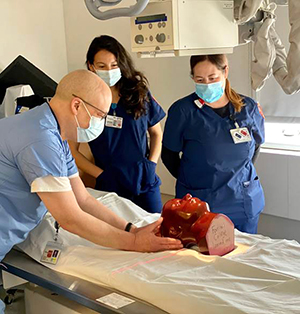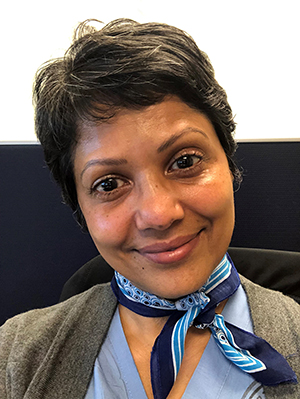UCSF Radiologic Technologists Help Advance the Profession Through Teaching
 Radiologic technologists (RTs) are health care professionals who perform diagnostic imaging procedures, such as X-ray exams, MRI, and CT scans. They work closely with radiologists and radiology nurses to ensure accurate, quality images and patient-centered care. The profession has advanced exponentially over the last decade to include specialized imaging techniques and procedures, and as the profession grows, so does the demand for qualified RTs.
Radiologic technologists (RTs) are health care professionals who perform diagnostic imaging procedures, such as X-ray exams, MRI, and CT scans. They work closely with radiologists and radiology nurses to ensure accurate, quality images and patient-centered care. The profession has advanced exponentially over the last decade to include specialized imaging techniques and procedures, and as the profession grows, so does the demand for qualified RTs.
Here at UC San Francisco, education is part of our mission. General RTs at UCSF Radiology play an important role in preparing future RTs for their career ahead. To become credentialed, RTs must earn an associate or more advanced degree from an accredited hospital-based program or academic institution and pass a national certification board examination.
“UCSF RTs diligently engage in teaching, knowing that they are the catalyst for each student’s future success. Our RTs understand that the seeds planted by mentoring our students begin to flower in the next graduating class of RTs, who could potentially become their co -workers,” shares Alpana Patel Camilli, RT, BS, manager of Interventional Radiology at UCSF Medical Center. “Their roles as teachers are not specifically defined in their official job descriptions yet their passion for educating future technologists is key to disseminating the skills and knowledge needed to provide high quality, safe patient care. All of this demonstrates our genuine passion for providing a path to success for students.”
 In the Bay Area, UCSF Radiology is involved with the Diagnostic Medical Imaging (DMI) Program at City College of San Francisco (CCSF), accredited by both the American Registry of Radiologic Technologists (ARRT) and Joint Review Committee on Education in Radiologic Technology (JRCERT) and the Radiologic Technology Program at Foothill College, accredited by the JRCERT and the California Department of Public Health, Radiation Health Branch (RHB).
In the Bay Area, UCSF Radiology is involved with the Diagnostic Medical Imaging (DMI) Program at City College of San Francisco (CCSF), accredited by both the American Registry of Radiologic Technologists (ARRT) and Joint Review Committee on Education in Radiologic Technology (JRCERT) and the Radiologic Technology Program at Foothill College, accredited by the JRCERT and the California Department of Public Health, Radiation Health Branch (RHB).
“During the course of the pandemic, some learning moved to a virtual format, but our RTs continued to support the students and remained involved by providing their mentorship and expertise to future RTs in Bay Area training programs,” explains Patel Camilli. “Our technologist educators participated in online coursework in a virtual setting with the same dedication that they showed in a hospital setting.”
The UCSF Radiology contribution to Bay Area technologist training programs includes participation as leaders in classes on anatomy and positioning, training on physics and equipment, intermediate and advanced imaging procedures, and coordination of clinical education. Teaching involves quizzes, dedicated follow-up, observation, and real-time feedback. And beyond graduation, students often rely upon their teachers to provide continued advice and feedback.
